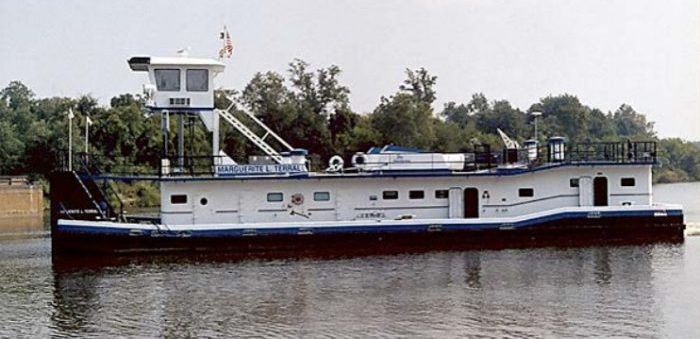On June 9, 2017, the towing vessel ‘Marguerite L. Terral’ was pushing a flotilla of six cargo barges downbound on the Atchafalaya River, Louisiana, west of Baton Rouge. At 1428 local time, the starboard lead barge in the tow and the barge immediately aft contacted a pier of the Union Pacific Railroad Bridge at mm 41.5. The allision resulted in damage to both barges and the bridge, totaling more than $4 million in repairs. The US NTSB issued an investigation report on the incident.
The NTSB determines that the probable cause of the allision of the Marguerite L. Terral tow with the Krotz Springs Railroad Bridge was the bridge tender’s delay in providing a timely opening of the drawspan, as requested, due to distraction by his other duties. Contributing to the accident was the pilot’s failure to properly compensate for the current during the approach to the bridge.
After investigation, the NTSB highlighted the following points:
- The current US law on drawbridges state that all drawbridges must open promptly and fully for the passage of vessels when an opening request is received. In this case, the pilot of the Marguerite L. Terral provided the first request at 1340 clearly stating to the bridge tender that he needed the railroad drawspan opened at his estimated time of arrival at 1420.
- The bridge tender obtained accordingly permission from Union Pacific’s engineering department to block all rail traffic between 1347 and 1445. Yet, instead of completing the rail and bridge assessment and then returning to the bridge tender’s station to open the drawspan, he was distracted by the unannounced visit from the company’s two supervisors and thereby lost awareness of the time that had passed.
“Such inspections should never interfere with the safety of bridge operations. The drawspan should have been opened and available for the Marguerite L. Terral to safely transit at the time requested.”
- The pilot did not take advantage of the risk mitigation policy in the company’s SMS, stating that assist tugs would be made available for bridge transits, when requested, to ensure safe passage during periods of strong currents caused by higher-than-normal river levels and other unfavorable conditions. Nevertheless, the pilot’s decision to not request such assistance was reasonable, considering that the river conditions at the time of the accident, though far from optimal, were not significantly adverse.
- The trackline of the vessel between the highway bridge and the railroad bridge obtained from the vessel’s electronic chart system confirmed that the force of the current had laterally set the tow toward the right descending bank. Although the pilot attempted to maintain a suitable heading as he approached the railroad bridge, he was unable to overcome the current. The pilot’s reduction of forward speed to allow time for the bridge tender to fully open the drawspan reduced the water flow across the vessel’s rudders and thus diminished control of the towing vessel and flotilla.
- When the pilot first became aware that the railroad drawspan was still in the closed position at the time he obtained a line of sight on the Krotz Springs Railroad Bridge at 1416, the Marguerite L. Terral tow was around mm 39.8 and above the Krotz Springs Highway Bridge. At this point, the pilot had at least 1.5 miles of distance to take necessary actions to prevent contact with the structure. These actions included attempting to stop the forward movement entirely or, if this strategy was not feasible as he indicated, attempting to further slow the downriver movement by applying astern propulsion and using the flanking rudder system to maintain control of the unit.
Explore more by reading the full report herebelow:































































